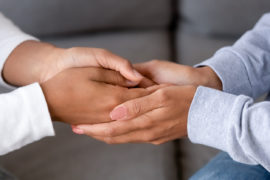 Cultural ideals when it comes to body types are that women can never be too thin and men can never be too buff. In addition to these cultural pressures, we suffer from confusing messages about what a healthy diet consists of.
Cultural ideals when it comes to body types are that women can never be too thin and men can never be too buff. In addition to these cultural pressures, we suffer from confusing messages about what a healthy diet consists of.
While we are pressured to be thin, we also exist in a world where fast food and giant portions are the norm, sending the message to “eat more!” This can often lead people to engage in eating disorders, which commonly co-occur with Borderline Personality Disorder (BPD).
The three main types of eating disorders are Anorexia Nervosa, Bulimia Nervosa, and Binge Eating Disorder. Below is a look at these three eating disorders and their common symptoms.
Anorexia Nervosa Symptoms
Anorexia Nervosa is the least common of the three types of eating disorders, but it has the highest mortality rate. According to the DSM-IV, anorexia is characterized as follows:
- A refusal to maintain a body weight at or above the normal range for one’s age and height (having a BMI under 85 percent)
- An intense fear of gaining weight or becoming fat, even though underweight
- A disturbance in the way one’s body weight or shape is experienced, undue influence of body weight or shape in self-evaluation, or denial of the seriousness of current body weight
- Amenorrhea: the absence of at least three consecutive menstrual cycles
The two subtypes of anorexia are the restricting type and the binge/purge type. Those with the disorder either reduce their caloric intake severely or binge on food and then abuse laxatives, vomiting, and diuretics to keep from gaining weight.
There are a number of serious health issues that can arise from Anorexia Nervosa, including menstrual or reproductive complications, gastrointestinal complications, and cardiovascular problems.
Often people suffering from anorexia don’t see themselves the way that others do and deny the seriousness of their current weight, even if they are severely underweight.
Bulimia Nervosa Symptoms
Bulimia Nervosa is characterized in the DSM-IV as follows:
- Recurrent episodes of binge eating characterized by both of the following: eating in a discrete period of time an amount of food that is larger than most people would eat in the same amount of time or under similar circumstances and a sense of loss of control over eating during episode
- Recurrent compensatory behavior in order to prevent weight gain, such as self-induced vomiting; misuse of laxatives, diuretics, enemas, or other medications; fasting; and excessive exercise
- Binge eating and compensatory behaviors average twice a week for three months
- Self-evaluation unduly influenced by body shape and weight
The two subtypes of Bulimia Nervosa are the purging type and the non-purging type. Purging types use vomiting and laxatives to prevent weight gain. Non-purging types use fasting and excessive exercise to keep weight down.
As with anorexia, there are many serious medical issues that can arise from bulimia, such as fluid and electrolyte damage, gastrointestinal complaints (such as constipation or irritable bowel), and dental decay as a result of excessive vomiting.
Both Anorexia Nervosa and Bulimia Nervosa carry high incidences of psychological problems, such as mood swings and depression, anxiety over food, low self-esteem, perfectionism, and social withdrawal.
Binge Eating Disorder Symptoms
Binge Eating Disorder is characterized in the DSM-IV the following way:
- Recurrent episodes of binge eating characterized by both of the following: eating in a discrete period of time an amount of food that is larger than most people would eat in the same amount of time or under similar circumstances
- A sense of loss of control over eating during episode
While those are the two primary characteristics of bulimia, Binge Eating Disorder is diagnosed when at least three of the following behaviors also occur:
- Eating much more rapidly than normal
- Eating until feeling uncomfortably full
- Eating large amounts of food when not feeling physically hungry
- Eating alone because of feeling embarrassed by how much one is eating
- Feeling disgusted with oneself, depressed, or very guilty after overeating
The DSM-IV further describes Binge Eating Disorder:
- Marked distress regarding binge eating
- The binge eating occurs, on average, at least two days a week for six months
- The disturbance does not occur exclusively during the course of Anorexia Nervosa or Bulimia Nervosa
Eating Disorder Treatment
As with any disorder, the earlier intervention occurs, the better chance there is of recovery. Regardless of what type of eating disorder you may have, the best hope for recovery is entering eating disorder treatment as soon as possible. Eating disorder treatment can help you to address your symptoms and issues that triggered your eating disorder and help you learn healthy ways to cope.
If you are struggling with an eating disorder along with Borderline Personality Disorder, find a BPD treatment center that addresses both disorders for the most complete recovery.




2 Comments
Pingback: Eating Disorders Linked to Genetics | Borderline Personality Treatment
Pingback: Coping with an Eating Disorder During the Holidays | Borderline Personality Treatment